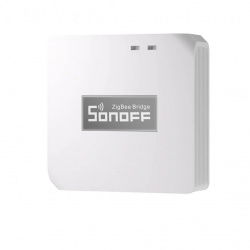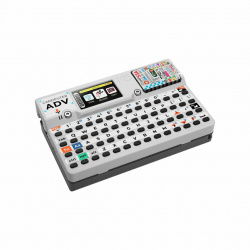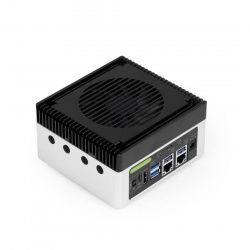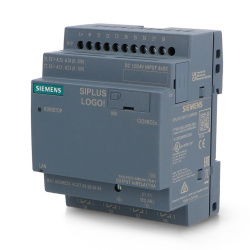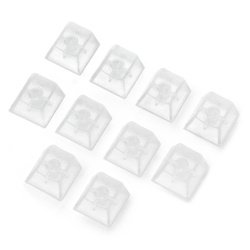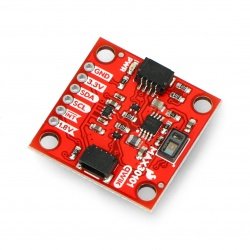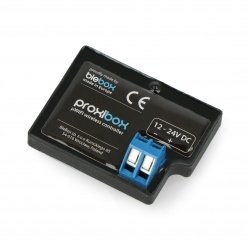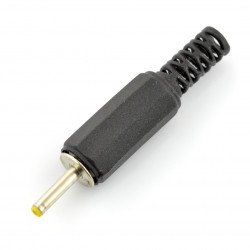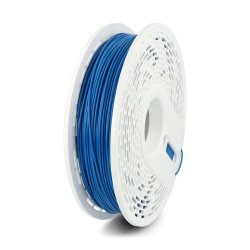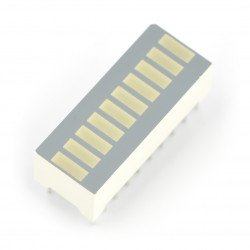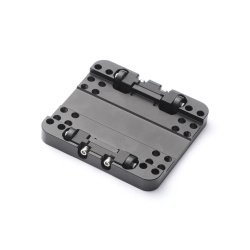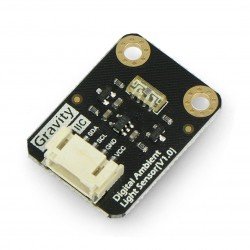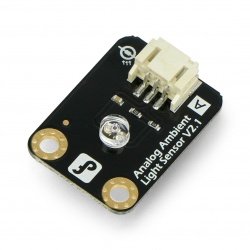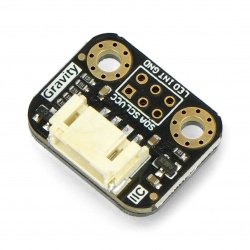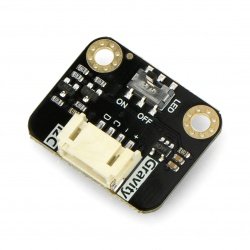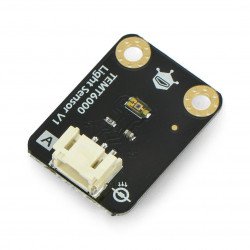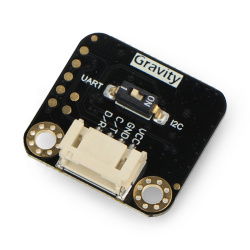Gravity - light and colour sensors
DFRobot Gravity - VEML7700 digital ambient light sensor - I2C
The module is compatible with Arduino, equipped with a digital light sensor with a resolution of 16-bit, it is powered with the voltage in the range from 3.3 V to 5.5 V. It...Gravity - UV ultraviolet light sensor - LTR390-UV-01 - I2C/UART - DFRobot SEN0540
Ultraviolet UV light sensor manufactured by DFRobot. It is equipped with the LTR390-UV-01 system that allows the measurement of radiation with a wavelength in the range from...DFRobot Gravity - analog sensor of ambient light
Analog ambient light sensor PT550 compatible with Arduino and Raspberry Pi. The sensor allows to determine the light density and reflects the analog voltage signal back to...DFRobot Gravity - an ultraviolet UV analog sensor
The UV light sensor is powered with the voltage of 5 V. The output is an analog voltage, proportional to the intensity of UV light intensity. The sensor can be used to detect...DFRobot Gravity - line tracking sensor - reflective, digital
Digital sensor of tracking the line, reflective for Arduino, it can detect the white and black lines. Separate signals provides a stable output signal TTL, so it looks for more...DFRobot TCS34725 RGB Color Sensor For Arduino
A module that allows you to make the function to determine the color of ambient light. Applied sensor TCS34725 with a LED backlight and a built-in IR filter. It communicates...Gravity - Color Sensor TCS3430 Tristimulus - DFRobot SEN0404
Manufactured by DFRobot, this colour sensor features the TCS3430 Tristimulus chip. It offers the user advanced digital ambient light detection (ALS) and CIE 1931...DFRobot Gravity - TEMT6000 analog light sensor
Analog ambient light sensor TEMT6000, compatible with Arduino. The sensor allows to determine the light density and reflects the analog voltage signal back to Arduino. The...Gravity - gesture sensor PAJ7620U2 - DFRobot SEN0315
The PAJ7620U2 based gesture sensor can recognize up to 13 different hand gestures at a distance of 20 cm. The module communicates using the popular I2C interface. It is...Gravity - ambient light and colour sensor - I2C/UART - DFRobot SEN0611
DFRobot brand module equipped with a light sensor, designed with professional photographers in mind. Thanks to factory calibration, it provides precise color temperature (CCT)...DFRobot Gravity - flame sensor 760-1100nm
The sensor is used to detect fire. It is powered with the voltage from 3.3 V to 5.3 V. The range of the sensed wave: from 760 nm to 1100 nm. The output is an analog voltage....DFRobot Gravity - grayscale sensor
Analog grey sensor which is able to measure the light intensity from black to white. Scale of gray is also defined as black and white, with the darkest shade of gray as black...DFRobot Gravity - IR receiver 38kHz
The IR receiver from the Gravity series, operating at a frequency of 38 kHz with a voltage of 5 V. The module allows to receive commands from the IR transmitter. The...Gravity - GR10-30 gesture sensor - UART, I2C - DFRobot SEN0561
The Gravity GR10-30 gesture sensor module, produced by DFRobot, is a great alternative to classic buttons or touch screens. It can recognize as many as 12 different gestures...See also
- Gravity - starter kits
- Gravity - base hats
- Gravity - accelerometers and gyroscopes
- Gravity - actuators
- Gravity - gas & dust sensors
- Gravity - medical sensors
- Gravity - distance sensors
- Gravity - current sensors
- Gravity - temperature sensors
- Gravity - force sensors and limit switches
- Gravity - LED
- Gravity - encoders and potentiometers
- Gravity - converters
- Gravity - communication modules
- Gravity - sound modules
- Gravity - relays
- Gravity - buttons, keys and joysticks
- Gravity - cables
- Gravity - displays
Light sensors
In light sensors, the first link in the measuring system is a photosensitive element, which is most often a photoresistor. It is a photosensitive resistor whose resistance changes depending on the intensity of light falling on its surface. When a photoresistor has a very high resistance at its terminals, it will be inaccessible to light. On the other hand, as a result of exposure to light, its resistance will decrease accordingly as the intensity of light falling on its surface increases. Photoresistive light intensity sensors may be used to build a twilight automatic device. In such a device, measurement of voltage drop on the photoresistor is performed in real time. After reaching a sufficiently low light intensity, in response to the measured value of the threshold voltage, the automatic device switches on the power supply of the external lighting (in order for the automatic device to work properly, the photoresistor sensor should be placed in a place which is optically inaccessible for the light from the lighting installation which is controlled by the device). Even more accurate measurement can be obtained using photodiode sensors. In photodiode, current flow occurs as a result of receiving light, which causes the release of electrons present in the structure of photodiode p-n junction. The current flowing through the photodiode is greater the higher the intensity of light reaching the photodiode.
Greyscale measurement with DFRobot sensors
In addition to standard solutions for light intensity and color scale measurement, we also offer custom solutions, such as gray scale sensors. The Gravity series grayscale sensor has been designed to perform light intensity measurements in the full range of colour grayscale. Such a sensor functions on the basis of the so-called optocoupler, which is a photoresistor combined with an LED diode. The grayscale measurement proportionally represents the light intensity emitted from the LED to the photoresistor. The Gravity series grayscale sensor is an analog sensor - the output signal from the sensor should be connected to one of the sockets in the "ANALOG" section of the Arduino base board. We also offer high quality licensed Arduino clones, such as the DFRduino from DFRobot. The most popular application where measurements are made with grayscale sensors is photography. When we take a picture with a digital camera, the reflected light from the environment is passed through RGB filters and it is converted into individual pixels of the photograph whose colors are determined according to the grayscale. You can also use the grayscale sensor to build a line follower robot.
































































































































































































































































































































